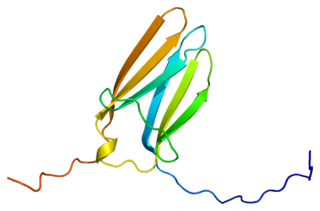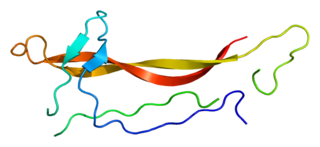Related Research Articles

The thalamus is a large mass of gray matter on the lateral walls of the third ventricle forming the dorsal part of the diencephalon. Nerve fibers project out of the thalamus to the cerebral cortex in all directions, known as the thalamocortical radiations, allowing hub-like exchanges of information. It has several functions, such as the relaying of sensory and motor signals to the cerebral cortex and the regulation of consciousness, sleep, and alertness.
The development of the nervous system, or neural development (neurodevelopment), refers to the processes that generate, shape, and reshape the nervous system of animals, from the earliest stages of embryonic development to adulthood. The field of neural development draws on both neuroscience and developmental biology to describe and provide insight into the cellular and molecular mechanisms by which complex nervous systems develop, from nematodes and fruit flies to mammals.

In the developing chordate, the neural tube is the embryonic precursor to the central nervous system, which is made up of the brain and spinal cord. The neural groove gradually deepens as the neural fold become elevated, and ultimately the folds meet and coalesce in the middle line and convert the groove into the closed neural tube. In humans, neural tube closure usually occurs by the fourth week of pregnancy.

Sonic hedgehog protein (SHH) is encoded for by the SHH gene. The protein is named after the video game character Sonic the Hedgehog.

Brain-derived neurotrophic factor (BDNF), or abrineurin, is a protein that, in humans, is encoded by the BDNF gene. BDNF is a member of the neurotrophin family of growth factors, which are related to the canonical nerve growth factor (NGF), a family which also includes NT-3 and NT-4/NT-5. Neurotrophic factors are found in the brain and the periphery. BDNF was first isolated from a pig brain in 1982 by Yves-Alain Barde and Hans Thoenen.

Neurotrophins are a family of proteins that induce the survival, development, and function of neurons.

Tropomyosin receptor kinase B (TrkB), also known as tyrosine receptor kinase B, or BDNF/NT-3 growth factors receptor or neurotrophic tyrosine kinase, receptor, type 2 is a protein that in humans is encoded by the NTRK2 gene. TrkB is a receptor for brain-derived neurotrophic factor (BDNF). The standard pronunciation for this protein is "track bee".

The p75 neurotrophin receptor (p75NTR) was first identified in 1973 as the low-affinity nerve growth factor receptor (LNGFR) before discovery that p75NTR bound other neurotrophins equally well as nerve growth factor. p75NTR is a neurotrophic factor receptor. Neurotrophic factor receptors bind Neurotrophins including Nerve growth factor, Neurotrophin-3, Brain-derived neurotrophic factor, and Neurotrophin-4. All neurotrophins bind to p75NTR. This also includes the immature pro-neurotrophin forms. Neurotrophic factor receptors, including p75NTR, are responsible for ensuring a proper density to target ratio of developing neurons, refining broader maps in development into precise connections. p75NTR is involved in pathways that promote neuronal survival and neuronal death.

Tropomyosin receptor kinase C (TrkC), also known as NT-3 growth factor receptor, neurotrophic tyrosine kinase receptor type 3, or TrkC tyrosine kinase is a protein that in humans is encoded by the NTRK3 gene.

Neurotrophin-3 is a protein that in humans is encoded by the NTF3 gene.
Dr. David D. Ginty is an American neuroscientist and developmental biologist.
Trk receptors are a family of tyrosine kinases that regulates synaptic strength and plasticity in the mammalian nervous system. Trk receptors affect neuronal survival and differentiation through several signaling cascades. However, the activation of these receptors also has significant effects on functional properties of neurons.
Michael Greenberg is an American neuroscientist who specializes in molecular neurobiology. He served as the Chair of the Department of Neurobiology at Harvard Medical School from 2008 to 2022.
Neurotrophic factor receptors or neurotrophin receptors are a group of growth factor receptors which specifically bind to neurotrophins.
Endogenous regeneration in the brain is the ability of cells to engage in the repair and regeneration process. While the brain has a limited capacity for regeneration, endogenous neural stem cells, as well as numerous pro-regenerative molecules, can participate in replacing and repairing damaged or diseased neurons and glial cells. Another benefit that can be achieved by using endogenous regeneration could be avoiding an immune response from the host.

The Department of Neurobiology at Harvard Medical School is located in the Longwood Medical Area of Boston, MA. It is consistently ranked as one of the top programs in Neurobiology and behavior in the world. The Department is part of the Basic Research Program at Harvard Medical School, with research pertaining to development of the nervous system, sensory neuroscience, neurophysiology, and behavior. The Department was founded by Stephen W. Kuffler in 1966, the first department dedicated to Neurobiology in the world. The mission of the Department is “to understand the workings of the brain through basic research and to use that knowledge to work toward preventive and therapeutic methods that alleviate neurological diseases”.
Lauren Orefice is an American neuroscientist and assistant professor in the Department of Molecular Biology at Massachusetts General Hospital and in the Department of Genetics at Harvard Medical School. Orefice has made innovative discoveries about the role of peripheral nerves and sensory hypersensitivity in the development of Autism-like behaviors. Her research now focuses on exploring the basic biology of somatosensory neural circuits for both touch and gastrointestinal function in order to shed light on how peripheral sensation impacts brain development and susceptibility to diseases like Autism Spectrum Disorders.

Farah D. Lubin is an American neuroscientist and Professor of Neurobiology and Cell, Developmental, and Integrative Biology at the University of Alabama at Birmingham within the Heersink School of Medicine. Lubin is the Principal Investigator of the Lubin Lab which explores the epigenetic mechanisms underlying cognition and how these mechanisms are altered in disease states such as epilepsy and neurodegeneration. Lubin discovered the role of NF-κB in fear memory reconsolidation and also uncovered a novel role for epigenetic regulation of BDNF during long-term memory formation and in epilepsy leading to memory loss. Lubin is a champion for diversity at UAB as the Director of the Roadmap Scholar Program and as a faculty mentor for several institutional and national programs to increase retention of underrepresented minorities in STEM.
Corey C. Harwell is an American neuroscientist who is an assistant professor in the Department of Neurobiology at Harvard Medical School.
Mary Kay Lobo is an American psychiatric neuroscientist who is a Professor of Neurobiology at the University of Maryland School of Medicine. Her research considers the molecular mechanisms that underpin drug addiction and depression. She was named a finalist in the 2011 Blavatnik Awards for Young Scientists.
References
- ↑ "Dr. Rosalind Segal appointed as the new Director of the Program in Neuroscience at Harvard Medical School : Dana Farber PLGA". danafarberplga.org. Retrieved 6 July 2016.
- ↑ "Rosalind A. Segal Named HMS Dean for Graduate Education: Harvard Brain Science Initiative". https://brain.harvard.edu/ . Retrieved 2024-07-06.
{{cite web}}: Check date values in:|access-date=(help); External link in|website= - ↑ "Speakers". harvard.edu.
- ↑ "JSMF - Grant Archive - 2000 - Rosalind A. Segal - Genetic Modifiers of Medulloblastoma". www.jsmf.org.
- ↑ "Recipients 06 - NIH Common Fund". commonfund.nih.gov. Archived from the original on 29 May 2016.
- ↑ "Awards and Honors - Dana–Farber Cancer Institute - Boston, MA". www.dana-farber.org. 25 March 2024.